2019 LAW00150 Business Law Assignment: Legal Problems & Short Answers
VerifiedAdded on 2022/12/05
|7
|1969
|133
Homework Assignment
AI Summary
This document presents a comprehensive solution to a Business Law assignment, addressing various legal problems and scenarios. The assignment covers key concepts in contract law, including intention, consideration, exclusion clauses, and implied conditions. The solution analyzes relevant case law, such as Ermogenous v Greek Orthodox Community, Foakes v Beer, and Thornton v Shoe Lane Parking Ltd, to provide reasoned answers to the questions posed. The document explores the impact of the High Court's decision on intention, the enforceability of clauses, the validity of amended contracts involving part payment, and the presence of consideration in different situations. Furthermore, it examines the validity of exclusion clauses and implied conditions in the sale of goods. The document provides detailed explanations, legal reasoning, and conclusions for each question, supported by citations to relevant legal precedents and academic sources. The assignment solution demonstrates a clear understanding of business law principles and their application to real-world scenarios.
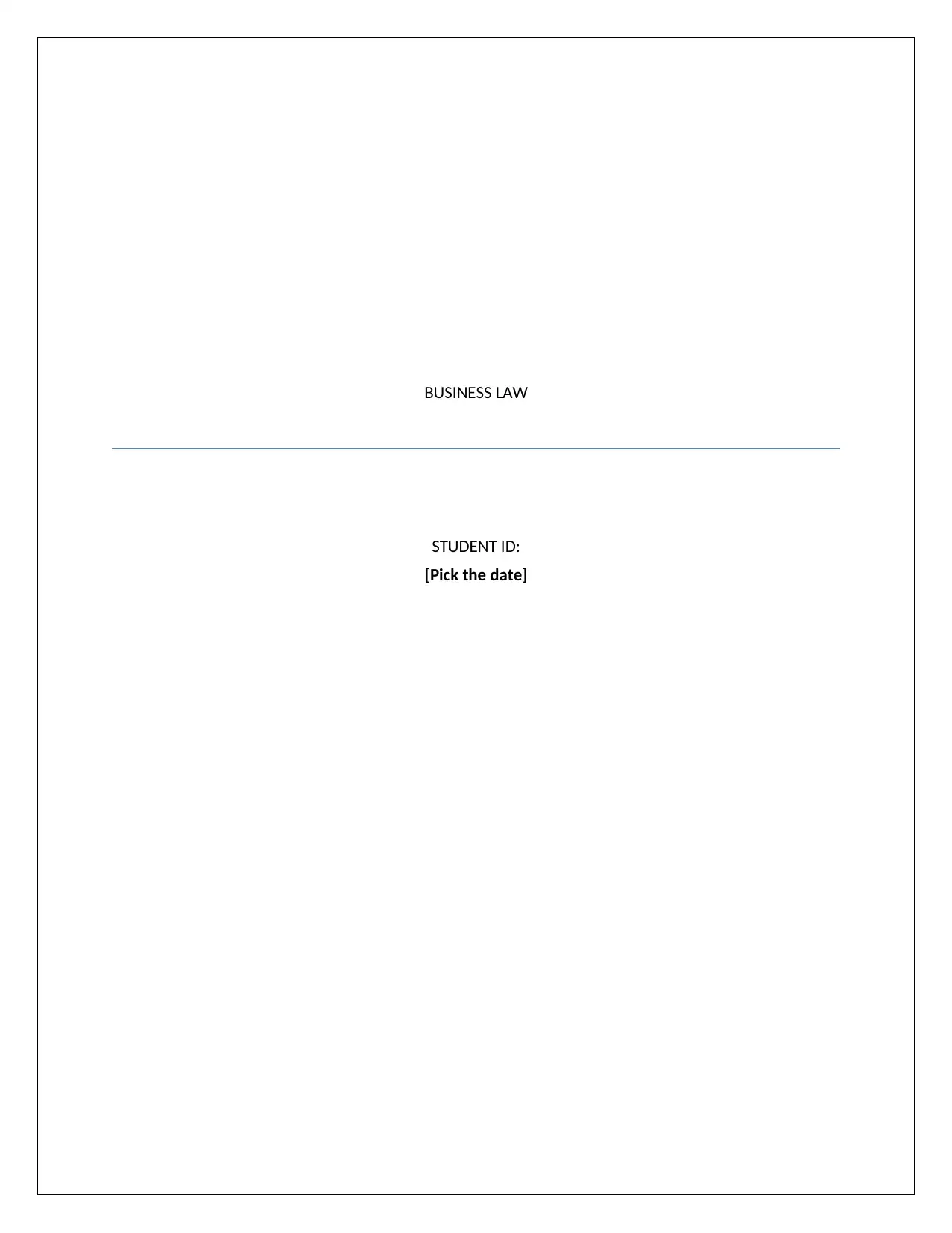
BUSINESS LAW
STUDENT ID:
[Pick the date]
STUDENT ID:
[Pick the date]
Paraphrase This Document
Need a fresh take? Get an instant paraphrase of this document with our AI Paraphraser
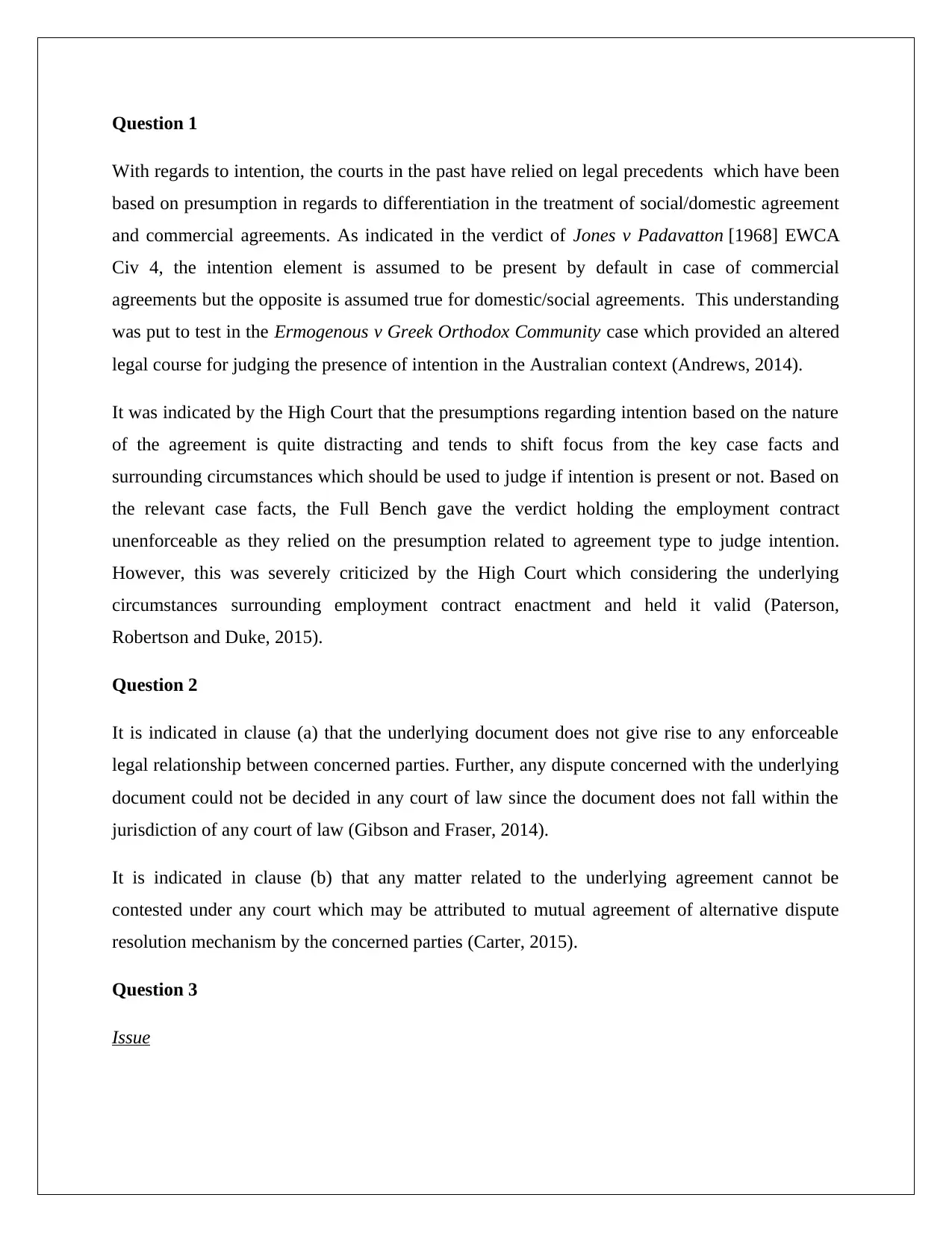
Question 1
With regards to intention, the courts in the past have relied on legal precedents which have been
based on presumption in regards to differentiation in the treatment of social/domestic agreement
and commercial agreements. As indicated in the verdict of Jones v Padavatton [1968] EWCA
Civ 4, the intention element is assumed to be present by default in case of commercial
agreements but the opposite is assumed true for domestic/social agreements. This understanding
was put to test in the Ermogenous v Greek Orthodox Community case which provided an altered
legal course for judging the presence of intention in the Australian context (Andrews, 2014).
It was indicated by the High Court that the presumptions regarding intention based on the nature
of the agreement is quite distracting and tends to shift focus from the key case facts and
surrounding circumstances which should be used to judge if intention is present or not. Based on
the relevant case facts, the Full Bench gave the verdict holding the employment contract
unenforceable as they relied on the presumption related to agreement type to judge intention.
However, this was severely criticized by the High Court which considering the underlying
circumstances surrounding employment contract enactment and held it valid (Paterson,
Robertson and Duke, 2015).
Question 2
It is indicated in clause (a) that the underlying document does not give rise to any enforceable
legal relationship between concerned parties. Further, any dispute concerned with the underlying
document could not be decided in any court of law since the document does not fall within the
jurisdiction of any court of law (Gibson and Fraser, 2014).
It is indicated in clause (b) that any matter related to the underlying agreement cannot be
contested under any court which may be attributed to mutual agreement of alternative dispute
resolution mechanism by the concerned parties (Carter, 2015).
Question 3
Issue
With regards to intention, the courts in the past have relied on legal precedents which have been
based on presumption in regards to differentiation in the treatment of social/domestic agreement
and commercial agreements. As indicated in the verdict of Jones v Padavatton [1968] EWCA
Civ 4, the intention element is assumed to be present by default in case of commercial
agreements but the opposite is assumed true for domestic/social agreements. This understanding
was put to test in the Ermogenous v Greek Orthodox Community case which provided an altered
legal course for judging the presence of intention in the Australian context (Andrews, 2014).
It was indicated by the High Court that the presumptions regarding intention based on the nature
of the agreement is quite distracting and tends to shift focus from the key case facts and
surrounding circumstances which should be used to judge if intention is present or not. Based on
the relevant case facts, the Full Bench gave the verdict holding the employment contract
unenforceable as they relied on the presumption related to agreement type to judge intention.
However, this was severely criticized by the High Court which considering the underlying
circumstances surrounding employment contract enactment and held it valid (Paterson,
Robertson and Duke, 2015).
Question 2
It is indicated in clause (a) that the underlying document does not give rise to any enforceable
legal relationship between concerned parties. Further, any dispute concerned with the underlying
document could not be decided in any court of law since the document does not fall within the
jurisdiction of any court of law (Gibson and Fraser, 2014).
It is indicated in clause (b) that any matter related to the underlying agreement cannot be
contested under any court which may be attributed to mutual agreement of alternative dispute
resolution mechanism by the concerned parties (Carter, 2015).
Question 3
Issue
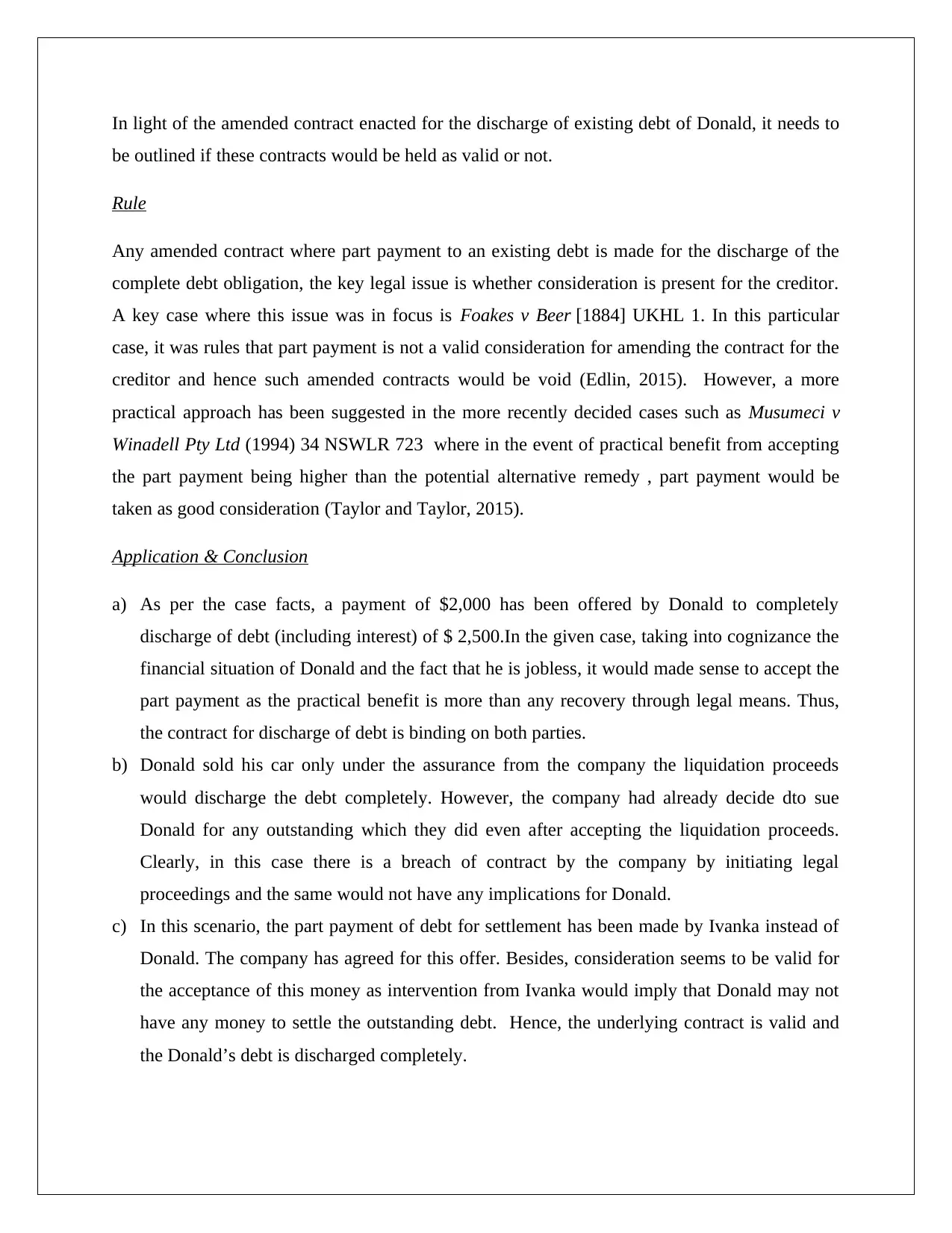
In light of the amended contract enacted for the discharge of existing debt of Donald, it needs to
be outlined if these contracts would be held as valid or not.
Rule
Any amended contract where part payment to an existing debt is made for the discharge of the
complete debt obligation, the key legal issue is whether consideration is present for the creditor.
A key case where this issue was in focus is Foakes v Beer [1884] UKHL 1. In this particular
case, it was rules that part payment is not a valid consideration for amending the contract for the
creditor and hence such amended contracts would be void (Edlin, 2015). However, a more
practical approach has been suggested in the more recently decided cases such as Musumeci v
Winadell Pty Ltd (1994) 34 NSWLR 723 where in the event of practical benefit from accepting
the part payment being higher than the potential alternative remedy , part payment would be
taken as good consideration (Taylor and Taylor, 2015).
Application & Conclusion
a) As per the case facts, a payment of $2,000 has been offered by Donald to completely
discharge of debt (including interest) of $ 2,500.In the given case, taking into cognizance the
financial situation of Donald and the fact that he is jobless, it would made sense to accept the
part payment as the practical benefit is more than any recovery through legal means. Thus,
the contract for discharge of debt is binding on both parties.
b) Donald sold his car only under the assurance from the company the liquidation proceeds
would discharge the debt completely. However, the company had already decide dto sue
Donald for any outstanding which they did even after accepting the liquidation proceeds.
Clearly, in this case there is a breach of contract by the company by initiating legal
proceedings and the same would not have any implications for Donald.
c) In this scenario, the part payment of debt for settlement has been made by Ivanka instead of
Donald. The company has agreed for this offer. Besides, consideration seems to be valid for
the acceptance of this money as intervention from Ivanka would imply that Donald may not
have any money to settle the outstanding debt. Hence, the underlying contract is valid and
the Donald’s debt is discharged completely.
be outlined if these contracts would be held as valid or not.
Rule
Any amended contract where part payment to an existing debt is made for the discharge of the
complete debt obligation, the key legal issue is whether consideration is present for the creditor.
A key case where this issue was in focus is Foakes v Beer [1884] UKHL 1. In this particular
case, it was rules that part payment is not a valid consideration for amending the contract for the
creditor and hence such amended contracts would be void (Edlin, 2015). However, a more
practical approach has been suggested in the more recently decided cases such as Musumeci v
Winadell Pty Ltd (1994) 34 NSWLR 723 where in the event of practical benefit from accepting
the part payment being higher than the potential alternative remedy , part payment would be
taken as good consideration (Taylor and Taylor, 2015).
Application & Conclusion
a) As per the case facts, a payment of $2,000 has been offered by Donald to completely
discharge of debt (including interest) of $ 2,500.In the given case, taking into cognizance the
financial situation of Donald and the fact that he is jobless, it would made sense to accept the
part payment as the practical benefit is more than any recovery through legal means. Thus,
the contract for discharge of debt is binding on both parties.
b) Donald sold his car only under the assurance from the company the liquidation proceeds
would discharge the debt completely. However, the company had already decide dto sue
Donald for any outstanding which they did even after accepting the liquidation proceeds.
Clearly, in this case there is a breach of contract by the company by initiating legal
proceedings and the same would not have any implications for Donald.
c) In this scenario, the part payment of debt for settlement has been made by Ivanka instead of
Donald. The company has agreed for this offer. Besides, consideration seems to be valid for
the acceptance of this money as intervention from Ivanka would imply that Donald may not
have any money to settle the outstanding debt. Hence, the underlying contract is valid and
the Donald’s debt is discharged completely.
⊘ This is a preview!⊘
Do you want full access?
Subscribe today to unlock all pages.

Trusted by 1+ million students worldwide
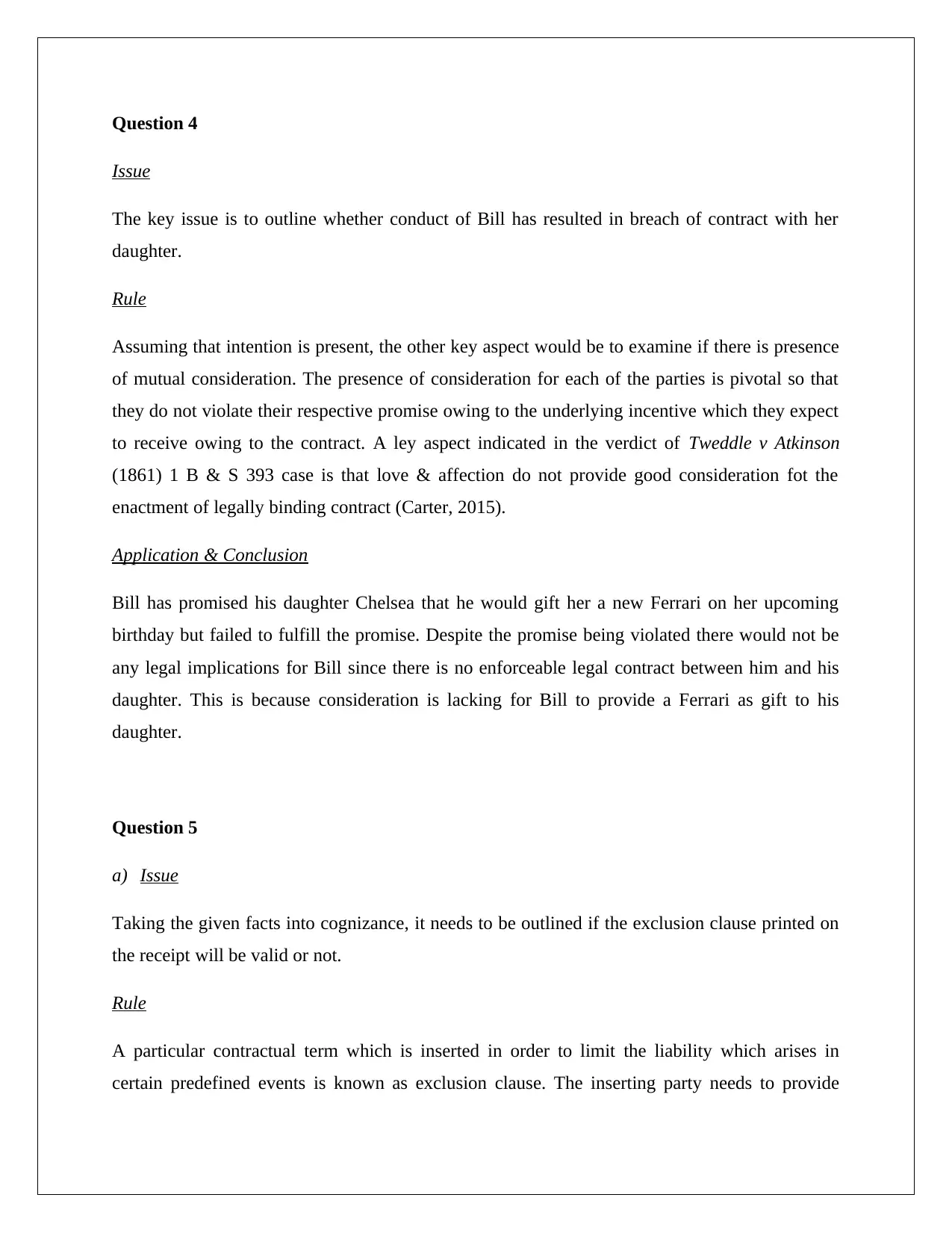
Question 4
Issue
The key issue is to outline whether conduct of Bill has resulted in breach of contract with her
daughter.
Rule
Assuming that intention is present, the other key aspect would be to examine if there is presence
of mutual consideration. The presence of consideration for each of the parties is pivotal so that
they do not violate their respective promise owing to the underlying incentive which they expect
to receive owing to the contract. A ley aspect indicated in the verdict of Tweddle v Atkinson
(1861) 1 B & S 393 case is that love & affection do not provide good consideration fot the
enactment of legally binding contract (Carter, 2015).
Application & Conclusion
Bill has promised his daughter Chelsea that he would gift her a new Ferrari on her upcoming
birthday but failed to fulfill the promise. Despite the promise being violated there would not be
any legal implications for Bill since there is no enforceable legal contract between him and his
daughter. This is because consideration is lacking for Bill to provide a Ferrari as gift to his
daughter.
Question 5
a) Issue
Taking the given facts into cognizance, it needs to be outlined if the exclusion clause printed on
the receipt will be valid or not.
Rule
A particular contractual term which is inserted in order to limit the liability which arises in
certain predefined events is known as exclusion clause. The inserting party needs to provide
Issue
The key issue is to outline whether conduct of Bill has resulted in breach of contract with her
daughter.
Rule
Assuming that intention is present, the other key aspect would be to examine if there is presence
of mutual consideration. The presence of consideration for each of the parties is pivotal so that
they do not violate their respective promise owing to the underlying incentive which they expect
to receive owing to the contract. A ley aspect indicated in the verdict of Tweddle v Atkinson
(1861) 1 B & S 393 case is that love & affection do not provide good consideration fot the
enactment of legally binding contract (Carter, 2015).
Application & Conclusion
Bill has promised his daughter Chelsea that he would gift her a new Ferrari on her upcoming
birthday but failed to fulfill the promise. Despite the promise being violated there would not be
any legal implications for Bill since there is no enforceable legal contract between him and his
daughter. This is because consideration is lacking for Bill to provide a Ferrari as gift to his
daughter.
Question 5
a) Issue
Taking the given facts into cognizance, it needs to be outlined if the exclusion clause printed on
the receipt will be valid or not.
Rule
A particular contractual term which is inserted in order to limit the liability which arises in
certain predefined events is known as exclusion clause. The inserting party needs to provide
Paraphrase This Document
Need a fresh take? Get an instant paraphrase of this document with our AI Paraphraser
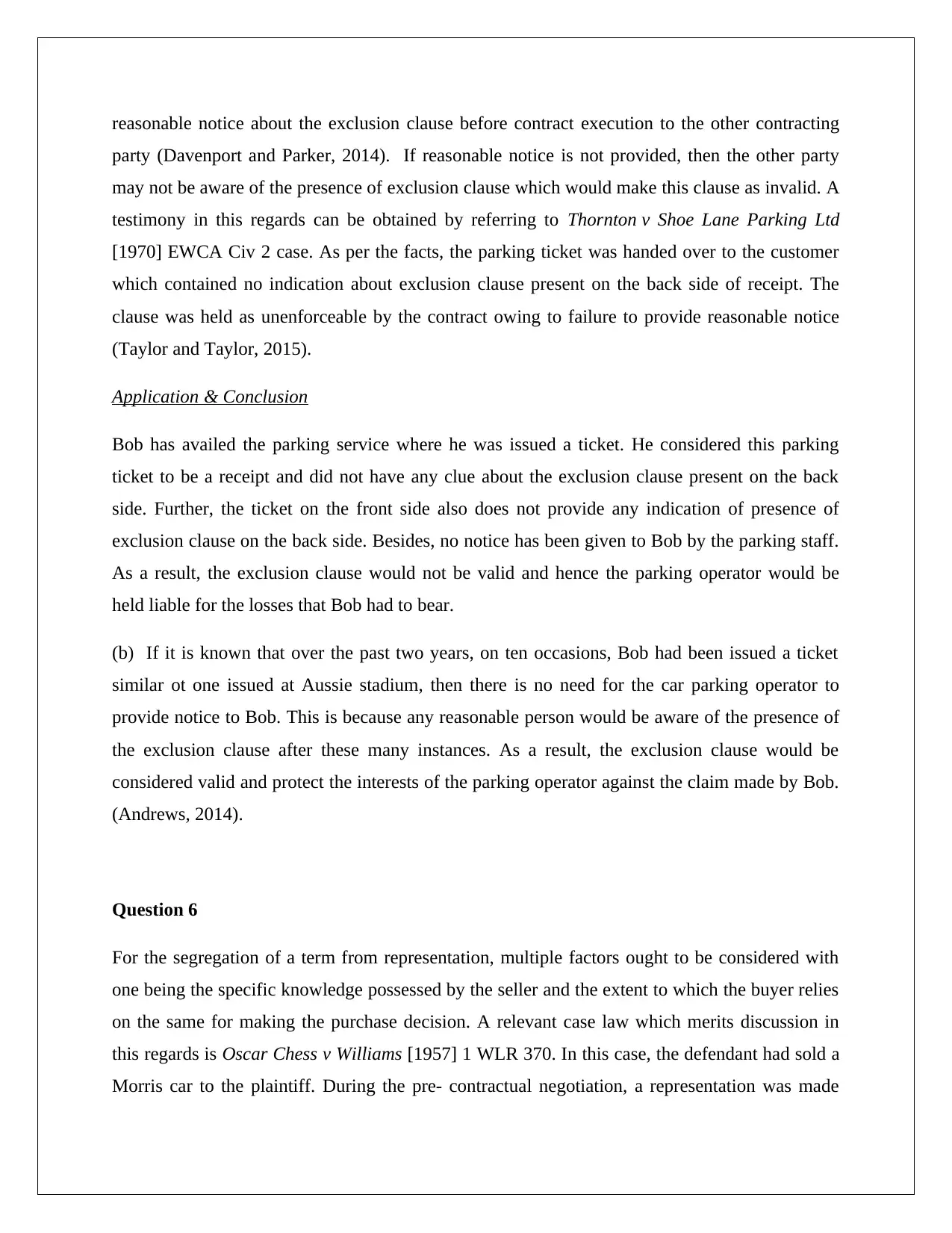
reasonable notice about the exclusion clause before contract execution to the other contracting
party (Davenport and Parker, 2014). If reasonable notice is not provided, then the other party
may not be aware of the presence of exclusion clause which would make this clause as invalid. A
testimony in this regards can be obtained by referring to Thornton v Shoe Lane Parking Ltd
[1970] EWCA Civ 2 case. As per the facts, the parking ticket was handed over to the customer
which contained no indication about exclusion clause present on the back side of receipt. The
clause was held as unenforceable by the contract owing to failure to provide reasonable notice
(Taylor and Taylor, 2015).
Application & Conclusion
Bob has availed the parking service where he was issued a ticket. He considered this parking
ticket to be a receipt and did not have any clue about the exclusion clause present on the back
side. Further, the ticket on the front side also does not provide any indication of presence of
exclusion clause on the back side. Besides, no notice has been given to Bob by the parking staff.
As a result, the exclusion clause would not be valid and hence the parking operator would be
held liable for the losses that Bob had to bear.
(b) If it is known that over the past two years, on ten occasions, Bob had been issued a ticket
similar ot one issued at Aussie stadium, then there is no need for the car parking operator to
provide notice to Bob. This is because any reasonable person would be aware of the presence of
the exclusion clause after these many instances. As a result, the exclusion clause would be
considered valid and protect the interests of the parking operator against the claim made by Bob.
(Andrews, 2014).
Question 6
For the segregation of a term from representation, multiple factors ought to be considered with
one being the specific knowledge possessed by the seller and the extent to which the buyer relies
on the same for making the purchase decision. A relevant case law which merits discussion in
this regards is Oscar Chess v Williams [1957] 1 WLR 370. In this case, the defendant had sold a
Morris car to the plaintiff. During the pre- contractual negotiation, a representation was made
party (Davenport and Parker, 2014). If reasonable notice is not provided, then the other party
may not be aware of the presence of exclusion clause which would make this clause as invalid. A
testimony in this regards can be obtained by referring to Thornton v Shoe Lane Parking Ltd
[1970] EWCA Civ 2 case. As per the facts, the parking ticket was handed over to the customer
which contained no indication about exclusion clause present on the back side of receipt. The
clause was held as unenforceable by the contract owing to failure to provide reasonable notice
(Taylor and Taylor, 2015).
Application & Conclusion
Bob has availed the parking service where he was issued a ticket. He considered this parking
ticket to be a receipt and did not have any clue about the exclusion clause present on the back
side. Further, the ticket on the front side also does not provide any indication of presence of
exclusion clause on the back side. Besides, no notice has been given to Bob by the parking staff.
As a result, the exclusion clause would not be valid and hence the parking operator would be
held liable for the losses that Bob had to bear.
(b) If it is known that over the past two years, on ten occasions, Bob had been issued a ticket
similar ot one issued at Aussie stadium, then there is no need for the car parking operator to
provide notice to Bob. This is because any reasonable person would be aware of the presence of
the exclusion clause after these many instances. As a result, the exclusion clause would be
considered valid and protect the interests of the parking operator against the claim made by Bob.
(Andrews, 2014).
Question 6
For the segregation of a term from representation, multiple factors ought to be considered with
one being the specific knowledge possessed by the seller and the extent to which the buyer relies
on the same for making the purchase decision. A relevant case law which merits discussion in
this regards is Oscar Chess v Williams [1957] 1 WLR 370. In this case, the defendant had sold a
Morris car to the plaintiff. During the pre- contractual negotiation, a representation was made
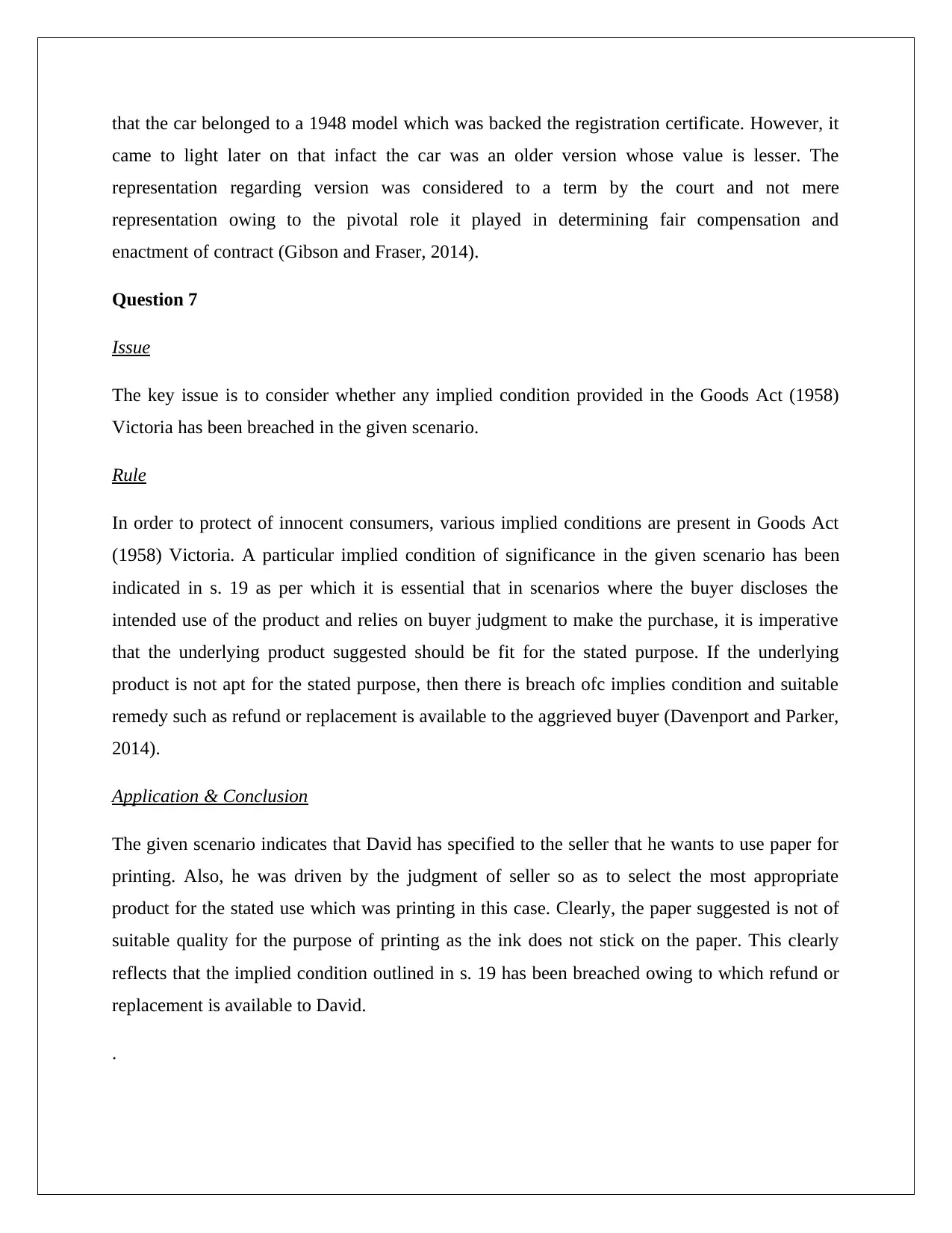
that the car belonged to a 1948 model which was backed the registration certificate. However, it
came to light later on that infact the car was an older version whose value is lesser. The
representation regarding version was considered to a term by the court and not mere
representation owing to the pivotal role it played in determining fair compensation and
enactment of contract (Gibson and Fraser, 2014).
Question 7
Issue
The key issue is to consider whether any implied condition provided in the Goods Act (1958)
Victoria has been breached in the given scenario.
Rule
In order to protect of innocent consumers, various implied conditions are present in Goods Act
(1958) Victoria. A particular implied condition of significance in the given scenario has been
indicated in s. 19 as per which it is essential that in scenarios where the buyer discloses the
intended use of the product and relies on buyer judgment to make the purchase, it is imperative
that the underlying product suggested should be fit for the stated purpose. If the underlying
product is not apt for the stated purpose, then there is breach ofc implies condition and suitable
remedy such as refund or replacement is available to the aggrieved buyer (Davenport and Parker,
2014).
Application & Conclusion
The given scenario indicates that David has specified to the seller that he wants to use paper for
printing. Also, he was driven by the judgment of seller so as to select the most appropriate
product for the stated use which was printing in this case. Clearly, the paper suggested is not of
suitable quality for the purpose of printing as the ink does not stick on the paper. This clearly
reflects that the implied condition outlined in s. 19 has been breached owing to which refund or
replacement is available to David.
.
came to light later on that infact the car was an older version whose value is lesser. The
representation regarding version was considered to a term by the court and not mere
representation owing to the pivotal role it played in determining fair compensation and
enactment of contract (Gibson and Fraser, 2014).
Question 7
Issue
The key issue is to consider whether any implied condition provided in the Goods Act (1958)
Victoria has been breached in the given scenario.
Rule
In order to protect of innocent consumers, various implied conditions are present in Goods Act
(1958) Victoria. A particular implied condition of significance in the given scenario has been
indicated in s. 19 as per which it is essential that in scenarios where the buyer discloses the
intended use of the product and relies on buyer judgment to make the purchase, it is imperative
that the underlying product suggested should be fit for the stated purpose. If the underlying
product is not apt for the stated purpose, then there is breach ofc implies condition and suitable
remedy such as refund or replacement is available to the aggrieved buyer (Davenport and Parker,
2014).
Application & Conclusion
The given scenario indicates that David has specified to the seller that he wants to use paper for
printing. Also, he was driven by the judgment of seller so as to select the most appropriate
product for the stated use which was printing in this case. Clearly, the paper suggested is not of
suitable quality for the purpose of printing as the ink does not stick on the paper. This clearly
reflects that the implied condition outlined in s. 19 has been breached owing to which refund or
replacement is available to David.
.
⊘ This is a preview!⊘
Do you want full access?
Subscribe today to unlock all pages.

Trusted by 1+ million students worldwide
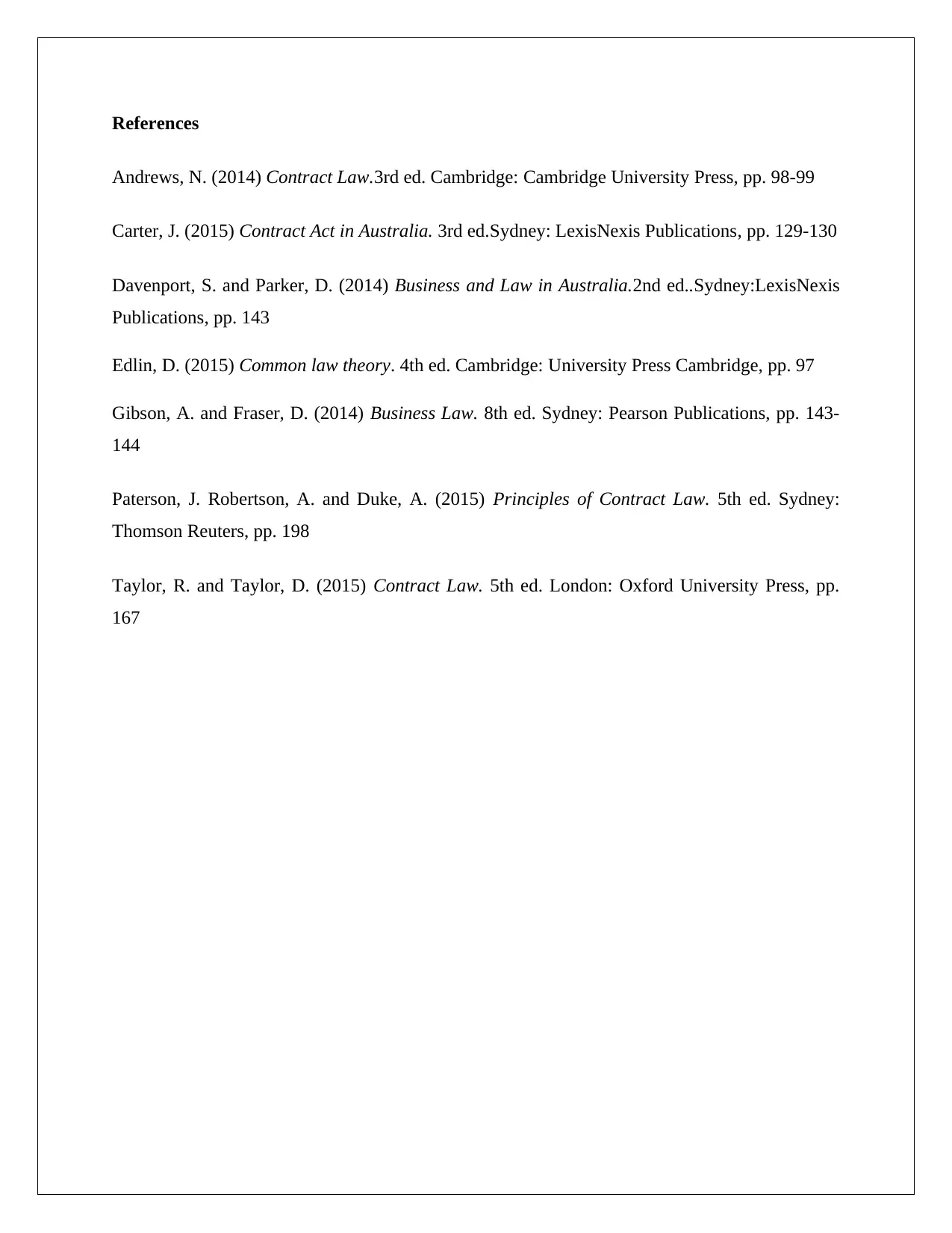
References
Andrews, N. (2014) Contract Law.3rd ed. Cambridge: Cambridge University Press, pp. 98-99
Carter, J. (2015) Contract Act in Australia. 3rd ed.Sydney: LexisNexis Publications, pp. 129-130
Davenport, S. and Parker, D. (2014) Business and Law in Australia.2nd ed..Sydney:LexisNexis
Publications, pp. 143
Edlin, D. (2015) Common law theory. 4th ed. Cambridge: University Press Cambridge, pp. 97
Gibson, A. and Fraser, D. (2014) Business Law. 8th ed. Sydney: Pearson Publications, pp. 143-
144
Paterson, J. Robertson, A. and Duke, A. (2015) Principles of Contract Law. 5th ed. Sydney:
Thomson Reuters, pp. 198
Taylor, R. and Taylor, D. (2015) Contract Law. 5th ed. London: Oxford University Press, pp.
167
Andrews, N. (2014) Contract Law.3rd ed. Cambridge: Cambridge University Press, pp. 98-99
Carter, J. (2015) Contract Act in Australia. 3rd ed.Sydney: LexisNexis Publications, pp. 129-130
Davenport, S. and Parker, D. (2014) Business and Law in Australia.2nd ed..Sydney:LexisNexis
Publications, pp. 143
Edlin, D. (2015) Common law theory. 4th ed. Cambridge: University Press Cambridge, pp. 97
Gibson, A. and Fraser, D. (2014) Business Law. 8th ed. Sydney: Pearson Publications, pp. 143-
144
Paterson, J. Robertson, A. and Duke, A. (2015) Principles of Contract Law. 5th ed. Sydney:
Thomson Reuters, pp. 198
Taylor, R. and Taylor, D. (2015) Contract Law. 5th ed. London: Oxford University Press, pp.
167
1 out of 7
Related Documents
Your All-in-One AI-Powered Toolkit for Academic Success.
+13062052269
info@desklib.com
Available 24*7 on WhatsApp / Email
![[object Object]](/_next/static/media/star-bottom.7253800d.svg)
Unlock your academic potential
Copyright © 2020–2025 A2Z Services. All Rights Reserved. Developed and managed by ZUCOL.




